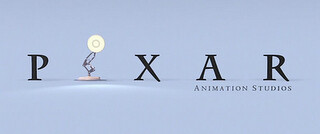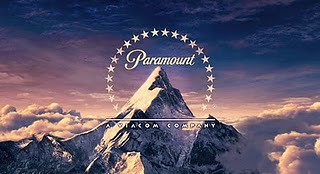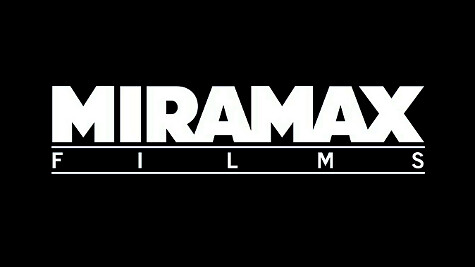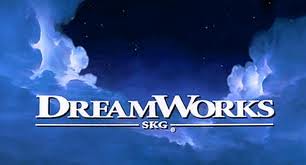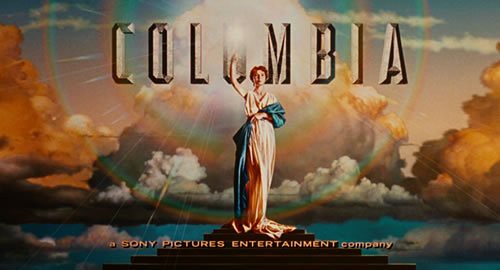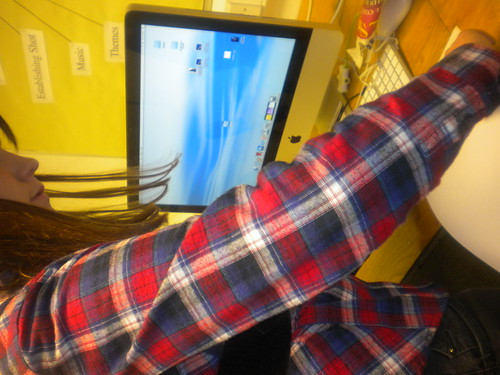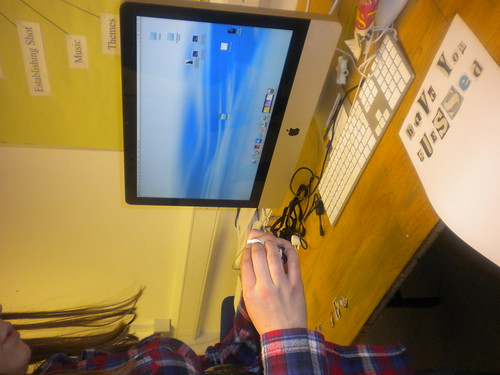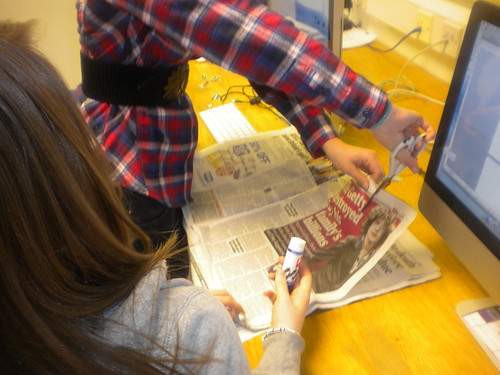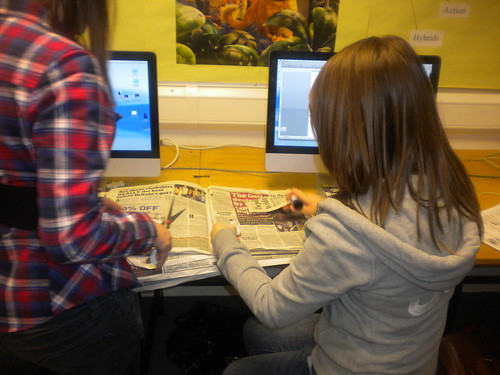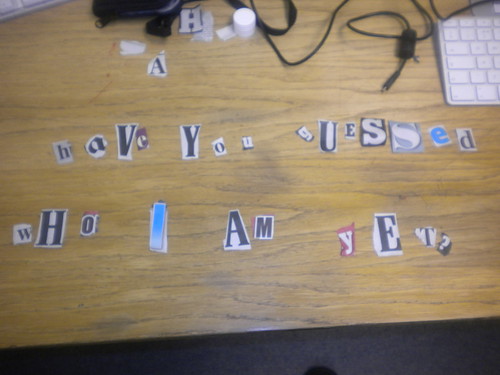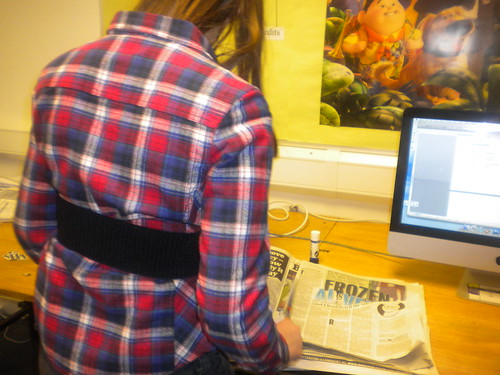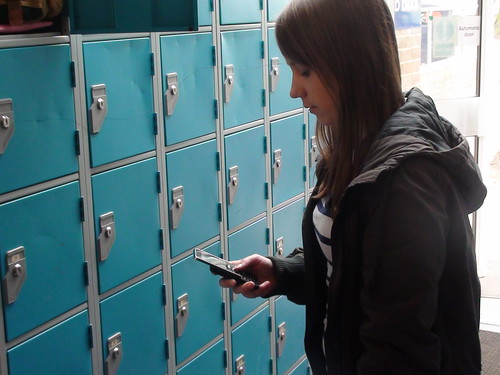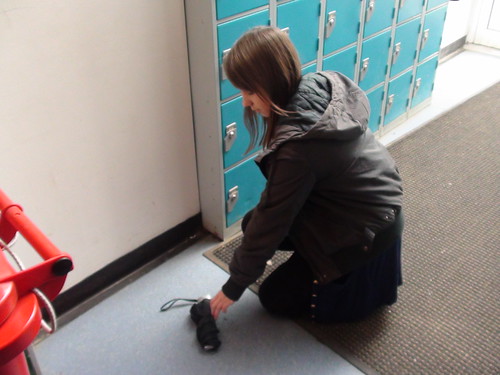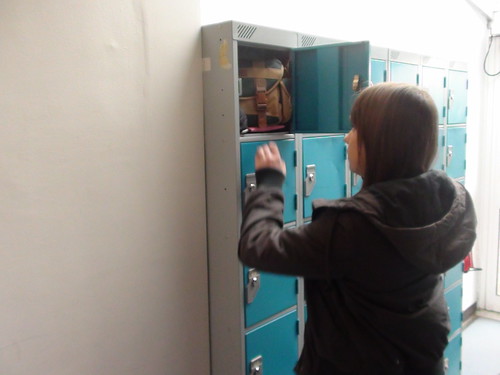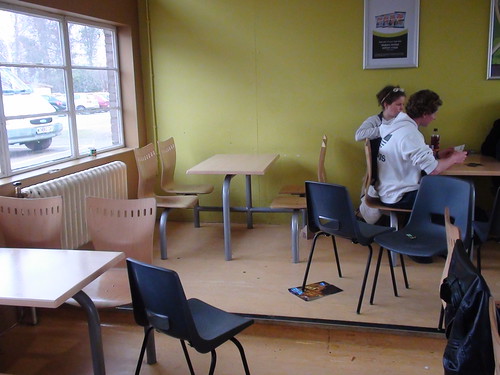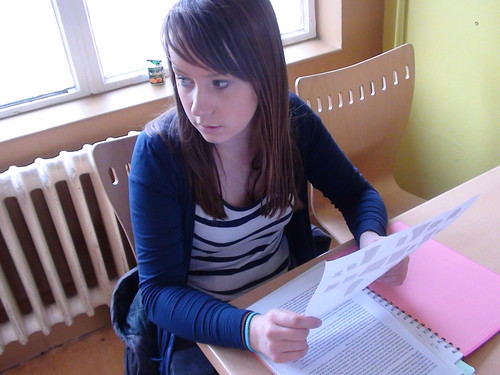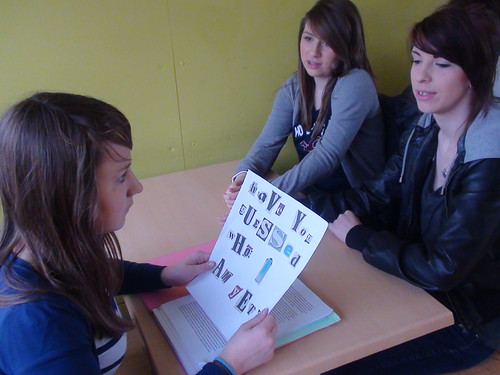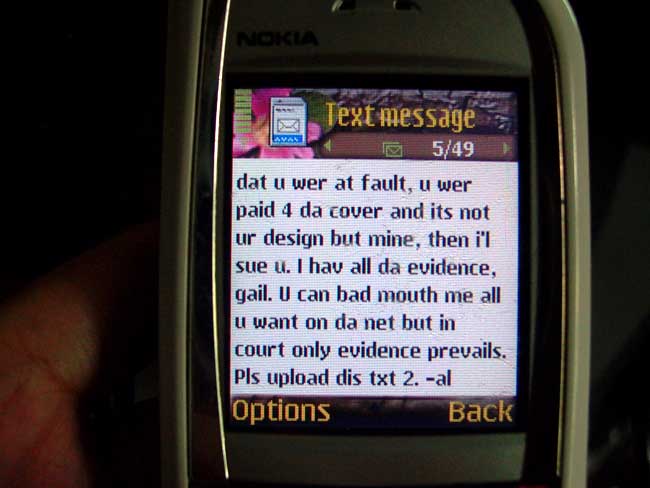
Friday, 25 March 2011
Thursday, 24 March 2011
Feedback On Our Thriller
Positive comments:
The point of view shot of the message was very clear.
The use of music in the introduction works well with transitions and the feeling of the film. The effects of the photographs are good.
The camera angles chosen make it feel like someone is following the character, building tension and creating suspense.
The polaroid picture at 1:30 was good and the sound effects worked well.
The use of handheld camerawork was good and it created a feeling that somebody was constantly watching the character.
The use of the closeups on important props and the characters faces were good as it helped show her emotions to create a mood.
The use of still images in the market scene were good as it helped feel like someone was watching her.
The polaroid photos of her while she was walking through the market were good. It gave a feel of suspense and uncertainty. The main character appears to have no idea of whose taking the photos.
The camerawork was clever such as the zooming in and the slow motion which added suspense.
The sound effects were good as it added tension.
The music was intense and it was good acting.
Good music, it went well with the footage. Good shot of the phone when she gets a text.
The use of the pictures building up on the screen is good as it builds tension as you know she is being stalked for a while.
The use of polaroid pictures was good and they were used well to give a sense of reality.
Things to improve on:
The background sound is too loud.
The scream at the end is too short.
The zoomed out shot of the stalkers note could of been clearer as you cant read what it says very easily.
To improve the sequence we could have considered a better setting and possibly somewhere not in college as the sound can become crowded and does not go with the sequence.
Couldn't read the note left in the book and the scream at the end sounded slightly unprofessional.
The sound effects of the photographs almost break the tension created with the music.
There should of been more focus on the letter as the viewer doesn't know what it says. Could of made use of the character talking to create more of a mood.
The ending of the sequence was a bit comic, not sure the scream worked well, could of used a fade instead.
The title sequence could of done with being more interesting.
The picture she's holding at 0:46 is hard to read, could of zoomed in further.
Could of made the background noise the same and not notice the change between shots.
The point of view shot of the message was very clear.
The use of music in the introduction works well with transitions and the feeling of the film. The effects of the photographs are good.
The camera angles chosen make it feel like someone is following the character, building tension and creating suspense.
The polaroid picture at 1:30 was good and the sound effects worked well.
The use of handheld camerawork was good and it created a feeling that somebody was constantly watching the character.
The use of the closeups on important props and the characters faces were good as it helped show her emotions to create a mood.
The use of still images in the market scene were good as it helped feel like someone was watching her.
The polaroid photos of her while she was walking through the market were good. It gave a feel of suspense and uncertainty. The main character appears to have no idea of whose taking the photos.
The camerawork was clever such as the zooming in and the slow motion which added suspense.
The sound effects were good as it added tension.
The music was intense and it was good acting.
Good music, it went well with the footage. Good shot of the phone when she gets a text.
The use of the pictures building up on the screen is good as it builds tension as you know she is being stalked for a while.
The use of polaroid pictures was good and they were used well to give a sense of reality.
Things to improve on:
The background sound is too loud.
The scream at the end is too short.
The zoomed out shot of the stalkers note could of been clearer as you cant read what it says very easily.
To improve the sequence we could have considered a better setting and possibly somewhere not in college as the sound can become crowded and does not go with the sequence.
Couldn't read the note left in the book and the scream at the end sounded slightly unprofessional.
The sound effects of the photographs almost break the tension created with the music.
There should of been more focus on the letter as the viewer doesn't know what it says. Could of made use of the character talking to create more of a mood.
The ending of the sequence was a bit comic, not sure the scream worked well, could of used a fade instead.
The title sequence could of done with being more interesting.
The picture she's holding at 0:46 is hard to read, could of zoomed in further.
Could of made the background noise the same and not notice the change between shots.
Tuesday, 22 March 2011
Thriller Pane
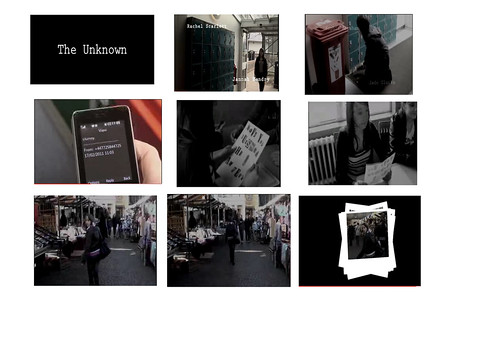
1- Title to the audience
2- Location and costume (establishing shot)
3- High angle shot
4- Prop and close up- (Use of the thriller convention of something out of the ordinary happening in ordinary situations- Her receiving the letter at school)
5- A thriller convention (gave a sense of danger)
6- Reaction shot showed with mid shot
7- Location
8- Long shot
9- Thriller convention (the build up of pictures gives a sense that the girl is being followed which follows the convention of building up suspense to the thrill of 'the unknown.' at the end.)
Friday, 18 March 2011
Tuesday, 15 March 2011
U1-29 Review
This group has used sound in their thriller opening really well. Both diegetic and non-diegetic sound have been clearly and clevery included in this opening, and the non-diegetic sound really shows their understanding of how to use it and where it's needed. I can tell that the non-diegetic sound that has been used is everyday background noises of cars etc, especially in the scene where Jess + Tom are playing football. The diegetic sound that you can hear throughout the clip is very clear considering they were filming outside and it was windy (often makes sounds quite fuzzy and hard to understand) but they managed to do it really well.
Friday, 11 March 2011
Thursday, 3 March 2011
Production Company Logo Ideas
We have decided to look at successful production company logos to help us decide on ideas when creating our own.




Labels:
Jade Clarke,
Jade Clarke and Rachel Scarlett and Sophie Abraham,
Janna Hendry and Rachel Scarlett
Tuesday, 1 March 2011
Sound Effects
We have added some tense music to certain parts of the sequence to help build up tension in crucial parts of the scenes. We also added louder more dramatic sounds when the titles came up to keep the viewer interested.
Thriller Opening Analysis
The opening title sequence I have decided to analyse is Vertigo (1960). The start of the title sequence, some intense music is used which creates a sense of mystery and tension, and these types of emotions are often created when watching a film in the genre of thriller.The use of dark lighting in the very first shot of an eye, is the first imperession we will have on the film, and due to this it unnoticeably makes us as an audience assume that it will be quite darkly lighted throughout the whole film. As darkness usually has conotataions of danger, the audeince will instantly start to come to terms with the fact that Vertigo is in the genre of a thriller or a horror.
It is not just the colour black that is related with danger and mystery, red is also known for this. So the fact that the black tint in the opening shot changes to red may suggest to the spectator that there could be some grusome scenes in this film, as red really portrays blood and gore.
It is not just the colour black that is related with danger and mystery, red is also known for this. So the fact that the black tint in the opening shot changes to red may suggest to the spectator that there could be some grusome scenes in this film, as red really portrays blood and gore.
Monday, 28 February 2011
Analysis Of Knowing Opening Title Sequence.
http://www.youtube.com/watch?v=rx7eaCCYv1U
Knowing
The colouring used in the film is very dark almost like there is a dark shadow over everything because when the sun appears through the black background which has tiny numbers covering it that initially look like stars before they grow in size it makes it look like it is the moon before it turns blue. The colouring of the footage of the girl is also very dark and everything around her is blurred which is in contrast to the shots of other characters which are bright. The text used in the film is white on a black background with what look like stars around it that blurs in and changes from a sequence of numbers to the text which gives the viewer a disorientated feeling because the so called stars suddenly change into numbers and what you thought was a night sky because of them and the sun is actually something completely different so you cannot tell what you are looking at. The first shot of the girl we see is a close up of her face while she is looking at the sun, it shows her eyes clearly that have a dark possessed look to them which is consistent with the convention of thrillers containing links to amnesia because the girl has a disturbed mind because she can hear voices and keeps writing numbers over and over again. Another convention used is that the main character is a girl and a lot of thrillers use the objectification of girls. The girl is also seen to be in peril when she is in the cupboard because she is covered in blood looking like she is typing and tells her teacher to help her get rid of the voices and these are the first words we hear her say so are important.
The sound used during the credits and during the shots of the girl is the sound of people whispering which really unnerves the viewer because you can hear it but not where it is coming from or what is being said. The non-diegetic background music is very low pitch long notes that help to add suspense to the atmosphere so you can tell that something is not quite right.
The costume used is basic clothing for the time in which this part of the film was set which is 1959. The setting is a school in Lexington, Massachusetts and because this is a very normal location it is consistent with the convention that something extraordinary is going to happen because this is during a very normal situation.
The Editing style used is continuity editing and this helps to create the feeling that the events are happening in real time and the girls state is getting worse because it goes from her staring at the sun to writing numbers to writing in blood on the walls.
The camerawork used is very clever because it zooms in on her face quite a lot which shows her very fragile state of mind very well because her eyes look very glazed over and her face looks white and pale unlike the other characters who look very bright. The high angle shot of the girl when she is in the cupboard makes her look very vulnerable and small because there is something in her head causing the voices which is overpowering her. The teacher is in contrast shown with low angle shots which gives her a feeling of authority over everyone and this is also shown by point of view shots from the girl up to the teacher showing she has control over the girl.
Knowing
The colouring used in the film is very dark almost like there is a dark shadow over everything because when the sun appears through the black background which has tiny numbers covering it that initially look like stars before they grow in size it makes it look like it is the moon before it turns blue. The colouring of the footage of the girl is also very dark and everything around her is blurred which is in contrast to the shots of other characters which are bright. The text used in the film is white on a black background with what look like stars around it that blurs in and changes from a sequence of numbers to the text which gives the viewer a disorientated feeling because the so called stars suddenly change into numbers and what you thought was a night sky because of them and the sun is actually something completely different so you cannot tell what you are looking at. The first shot of the girl we see is a close up of her face while she is looking at the sun, it shows her eyes clearly that have a dark possessed look to them which is consistent with the convention of thrillers containing links to amnesia because the girl has a disturbed mind because she can hear voices and keeps writing numbers over and over again. Another convention used is that the main character is a girl and a lot of thrillers use the objectification of girls. The girl is also seen to be in peril when she is in the cupboard because she is covered in blood looking like she is typing and tells her teacher to help her get rid of the voices and these are the first words we hear her say so are important.
The sound used during the credits and during the shots of the girl is the sound of people whispering which really unnerves the viewer because you can hear it but not where it is coming from or what is being said. The non-diegetic background music is very low pitch long notes that help to add suspense to the atmosphere so you can tell that something is not quite right.
The costume used is basic clothing for the time in which this part of the film was set which is 1959. The setting is a school in Lexington, Massachusetts and because this is a very normal location it is consistent with the convention that something extraordinary is going to happen because this is during a very normal situation.
The Editing style used is continuity editing and this helps to create the feeling that the events are happening in real time and the girls state is getting worse because it goes from her staring at the sun to writing numbers to writing in blood on the walls.
The camerawork used is very clever because it zooms in on her face quite a lot which shows her very fragile state of mind very well because her eyes look very glazed over and her face looks white and pale unlike the other characters who look very bright. The high angle shot of the girl when she is in the cupboard makes her look very vulnerable and small because there is something in her head causing the voices which is overpowering her. The teacher is in contrast shown with low angle shots which gives her a feeling of authority over everyone and this is also shown by point of view shots from the girl up to the teacher showing she has control over the girl.
Analysis of a thriller opening sequence
http://www.youtube.com/watch?v=Tek8QmKRODw
Psycho by Alfred Hitchcock
The colours used in this thriller opening sequence are black and grey. These are very dark and mysterious colours which are mostly used in horror/thriller films. The use of grey lines which are slightly close together sliding onto the page from different directions really confuses the viewer and the way the white lines fade out really shows the creepiness and the confusion of the film linking to the title 'Psycho'. The text is cut in half and then joined together as they grey lines move which shows how effective the thriller is messing with the viewers mind. The camera work is fast and has a good pace, by being fast and jumpy this excites the viewer. The music starts off with fast powerful low pitches from a violin and builds up to create tension. At the end of the opening sequence it ends with a sound of high pitched violins which finishes the sequence off dramatically and effectively. The music is very fast paced and lively which frightens the viewer and makes them unsure if they would want to watch on but keeps them going throughout the opening sequence and does not distract them.
The credits and music really draw the viewer into the film as they are so powerful. The way the credits are shown by being cut in half and moved around draws the viewer as they have become so fixed into what they are watching it makes it hard for them to stop. Not much mise en scene is used, no props, costumes as it is just the title opening sequence, but the way the credits are set out really confuses the eye and mind.
Psycho by Alfred Hitchcock
The colours used in this thriller opening sequence are black and grey. These are very dark and mysterious colours which are mostly used in horror/thriller films. The use of grey lines which are slightly close together sliding onto the page from different directions really confuses the viewer and the way the white lines fade out really shows the creepiness and the confusion of the film linking to the title 'Psycho'. The text is cut in half and then joined together as they grey lines move which shows how effective the thriller is messing with the viewers mind. The camera work is fast and has a good pace, by being fast and jumpy this excites the viewer. The music starts off with fast powerful low pitches from a violin and builds up to create tension. At the end of the opening sequence it ends with a sound of high pitched violins which finishes the sequence off dramatically and effectively. The music is very fast paced and lively which frightens the viewer and makes them unsure if they would want to watch on but keeps them going throughout the opening sequence and does not distract them.
The credits and music really draw the viewer into the film as they are so powerful. The way the credits are shown by being cut in half and moved around draws the viewer as they have become so fixed into what they are watching it makes it hard for them to stop. Not much mise en scene is used, no props, costumes as it is just the title opening sequence, but the way the credits are set out really confuses the eye and mind.
Sunday, 27 February 2011
Analysis of an opening title sequence of a thriller.
http://www.youtube.com/watch?v=pz46qS38OgM
This thriller produced by Alfred Hitchcock is extremely effective as it plays tricks on the viewer and how they see things. The opening title sequence is very much focused in on the eyes of this person, this is shown through the use of close ups and the amount of time spent on the one image. The camera uses slow zooms into the eye and remains there for a considerable amount of time, as the music increases in pace and volume. The music then has an air of dizziness about it as the image of the eye begins to change and we see a swirling image that replaces the eye. The use of the optical illusions in the title sequence of this thriller is effective as this is how the viewers mind is shook up and their view on how they see things changes as it becomes harder to look away and they become more and more fixated. The colour that is used in this shot is red which is a symbollic colour as it is strong and vivid, people associate the colour red with thrillers or disasters etc... The music slows down as we are taken into the image of the eye and it changes to the various optical illusions. The music has a much faster pace and is more high pitched, with short bursts of louder, stronger sounds inbetween at certain points. This keeps the viewer intruiged throughout the sequence and keeps them wanting to know what is going to happen as their anticipation builds at the same time as the pace of the music that is used. The short bursts of music have the effect on the viewer that they are reminded that things are not quite right and that soomething much more secretive or sinister is going on. The music is extremely dramatic as are the strong bold colours used and the illusions and images used to keep the viewer watching. The focus in on the eye is a convention used in the thriller genre a lot. This particular opening title sequence of a thriller however does challenge the conventions of a thriller in some ways as it does not use much mise en scene at all. There is no use of props or costumes to create such an atmosphere for the viewer, instead it is all based around the eye. Both the image of the eye in the sequence and they eyes of the viwer with the use of the optical illusions playing such a huge part in this opening title sequence.
This thriller produced by Alfred Hitchcock is extremely effective as it plays tricks on the viewer and how they see things. The opening title sequence is very much focused in on the eyes of this person, this is shown through the use of close ups and the amount of time spent on the one image. The camera uses slow zooms into the eye and remains there for a considerable amount of time, as the music increases in pace and volume. The music then has an air of dizziness about it as the image of the eye begins to change and we see a swirling image that replaces the eye. The use of the optical illusions in the title sequence of this thriller is effective as this is how the viewers mind is shook up and their view on how they see things changes as it becomes harder to look away and they become more and more fixated. The colour that is used in this shot is red which is a symbollic colour as it is strong and vivid, people associate the colour red with thrillers or disasters etc... The music slows down as we are taken into the image of the eye and it changes to the various optical illusions. The music has a much faster pace and is more high pitched, with short bursts of louder, stronger sounds inbetween at certain points. This keeps the viewer intruiged throughout the sequence and keeps them wanting to know what is going to happen as their anticipation builds at the same time as the pace of the music that is used. The short bursts of music have the effect on the viewer that they are reminded that things are not quite right and that soomething much more secretive or sinister is going on. The music is extremely dramatic as are the strong bold colours used and the illusions and images used to keep the viewer watching. The focus in on the eye is a convention used in the thriller genre a lot. This particular opening title sequence of a thriller however does challenge the conventions of a thriller in some ways as it does not use much mise en scene at all. There is no use of props or costumes to create such an atmosphere for the viewer, instead it is all based around the eye. Both the image of the eye in the sequence and they eyes of the viwer with the use of the optical illusions playing such a huge part in this opening title sequence.
Friday, 18 February 2011
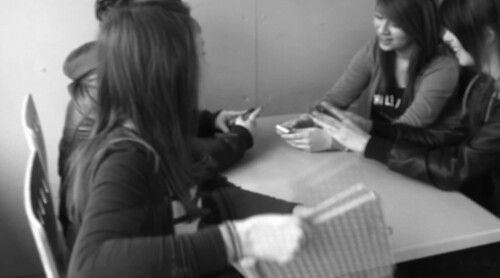
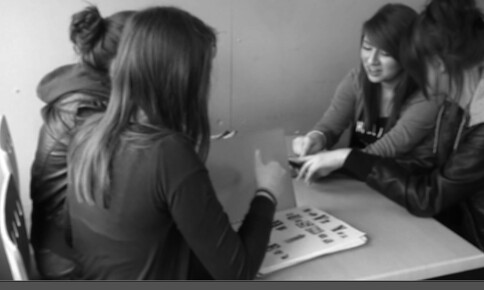
We decide to make these shots black and white to emphasise the old memory of the main character. We also made the decision to defocus these shots and slow the pace of the shots down, this created the idea of it being a memory more and had a larger impact on the viewer. we reduced the speed to 65 and defocused the shots twice.
Props And Costume List
Costume for all shots: Everyday clothing.
Shot 1: Props: Umbrella and other items in the locker.
Shot 2: Props: Mobile phone.
Shot 3: Props: Mobile phone.
Shot 4: Props: Folder, Letter written in newspaper cuttings, School bag.
Shots 5 & 6: Props: Folder, Letter.
Shot 7: Props: Photographic paper, Negatives, Processing trays, Tongs, Rubber gloves.
Shot 8 onwards: Props: Mobile phone, Handbag, Shopping bag.
Shot 1: Props: Umbrella and other items in the locker.
Shot 2: Props: Mobile phone.
Shot 3: Props: Mobile phone.
Shot 4: Props: Folder, Letter written in newspaper cuttings, School bag.
Shots 5 & 6: Props: Folder, Letter.
Shot 7: Props: Photographic paper, Negatives, Processing trays, Tongs, Rubber gloves.
Shot 8 onwards: Props: Mobile phone, Handbag, Shopping bag.
Thursday, 17 February 2011
Monday, 14 February 2011
Examples of images we will be using in our thriller piece:

I chose this image from the internet as it shows a threatening text. In our piece of film for our thriller the main character will recieve a text from an unknown number, numerous times. Although the texts will not be threatening neccesarily they will still have a similar impact on the character as they will contain information that only she will know or those near her will know, whilst nobody is there as she looks around.

The above image is chosen as in our thriller we will have a shot where the audience sees a contact sheet being developed. The contact sheet will have a number of images of people in various places. However there will be a few shots at the end of the camera film of the main charcater in the various places. This will help indicate that the stalker has been following her for a while now and it has been an ongoing thing without her even ever realising. These images of the main character will be highlighted so the audience will be aware that these shots are of importance and are the ones that they need to watch.

This image I chose because Half of our film will be shot in a woodland area at night. Although this picture is not taken in the evening or when it is dark it still shows a similar area that we plan to use. We will be shooting when it is slightly darker to create the atmosphere we want to create in our thriller.

In our thriller piece we will use the refectory in college to shoot one of our scenes. The scene where the main character reads her letter will be shot here, we chose this place as it is very ordinary and nothing strange or out of the blue. The refectory will be busy with people and the main character will be sat with her frineds who will be laughing and joking about. They will be slightly blurred as the main character reads the letter and the scene will be shot in black and white.
Friday, 11 February 2011
Thursday, 10 February 2011
Improvements On Children's Film
Watching our children opening film back, there are a few improvements that could be made to the sequence, such as
1. The length of the opening sequence is far too long for an opening sequence therefore we could of shortened it as it sort of drags on for too long and gives away the whole story.
2.Throughout the sequence, there are a lot of pauses which we could of improved on and made the clips faster as it draws away attention. This is a main area to improve on because the main thing to focus on is to draw peoples attention to the sequence and it needs to have a good flow.
3. Sound is also something to improve on. Background noise occurs in the sequence which shouldn't be in there which ruins the film a little bit. Also I feel as if we could of used more lively music in the sequence to represent happiness whereas I think the sequence is fairly quite and only has a few interesting noises in. Shadows and a few jumpy movements also occur in the sequence which we could of improved on. If we ever do this sort of thing again we know to be extra careful when performing this.
1. The length of the opening sequence is far too long for an opening sequence therefore we could of shortened it as it sort of drags on for too long and gives away the whole story.
2.Throughout the sequence, there are a lot of pauses which we could of improved on and made the clips faster as it draws away attention. This is a main area to improve on because the main thing to focus on is to draw peoples attention to the sequence and it needs to have a good flow.
3. Sound is also something to improve on. Background noise occurs in the sequence which shouldn't be in there which ruins the film a little bit. Also I feel as if we could of used more lively music in the sequence to represent happiness whereas I think the sequence is fairly quite and only has a few interesting noises in. Shadows and a few jumpy movements also occur in the sequence which we could of improved on. If we ever do this sort of thing again we know to be extra careful when performing this.
Test Footage
Before actually filming our final opening sequence, we decided it would be a wise idea to shoot a few practice shots of the scenes first. This gave us a rough idea of what we planned worked and an idea of what shots suited which scene best. A few of our shots did change due to location and space to work with. The first shot is now an establishing shot whereas before it was going to be an over the shoulder shot, and watching the footage back we prefer this shot compared to the first one as you can see more of the location and the character. We still have more test footage to continue with and various shots to experiment with.
Friday, 4 February 2011
Thursday, 3 February 2011
Shot List
1. Girl bends down to pick up something from the floor. Location: Lockers.
2. Close up of the text she receives by her locker. Everything is in focus. Props: Phone. Location: By the lockers in college.
3. Zoom in into the girls locker over her shoulder. Location: School corridor locker. The girl will be in focus but the locker will be blurred then blackout.
4. Long shot of girl sat in refectory with her friends. Location: Refectory. Slow motion and her friends blurred and she is in full focus with echoed laughs around her.
5. Close up of letter and girls hand holding the letter. Location: Refectory. Props: Letter. Letter in shot to see what it says.
6. Reaction shot of girl after reading the letter. Location: Refectory. Props: Letter. Mid shot- See the girl holding the letter and her face as she has read it.
7. Close up of a photo being developed. Location: Dark room. Props: Tongs, Photo/ Contact sheet. Split screen of developing photo and character in scene.
8. Long shot of the girl walking through the woodland area. Location: Woody area. (handheld camera work) Girl in the middle of the shot walking.
9. Camera is getting closer and closer to the character. The clicking of the camera speeds up as the pace of the girl speeds up too. Location: woodland area.
10. Close up of girl falling/tripping over the branch. Girl tripping and hear a scream as she falls.
11. Blackout while she screams.
2. Close up of the text she receives by her locker. Everything is in focus. Props: Phone. Location: By the lockers in college.
3. Zoom in into the girls locker over her shoulder. Location: School corridor locker. The girl will be in focus but the locker will be blurred then blackout.
4. Long shot of girl sat in refectory with her friends. Location: Refectory. Slow motion and her friends blurred and she is in full focus with echoed laughs around her.
5. Close up of letter and girls hand holding the letter. Location: Refectory. Props: Letter. Letter in shot to see what it says.
6. Reaction shot of girl after reading the letter. Location: Refectory. Props: Letter. Mid shot- See the girl holding the letter and her face as she has read it.
7. Close up of a photo being developed. Location: Dark room. Props: Tongs, Photo/ Contact sheet. Split screen of developing photo and character in scene.
8. Long shot of the girl walking through the woodland area. Location: Woody area. (handheld camera work) Girl in the middle of the shot walking.
9. Camera is getting closer and closer to the character. The clicking of the camera speeds up as the pace of the girl speeds up too. Location: woodland area.
10. Close up of girl falling/tripping over the branch. Girl tripping and hear a scream as she falls.
11. Blackout while she screams.
Tuesday, 1 February 2011
Why Thrillers Thrive...
'Why thrillers thrive' gives us a good detailed insight into the background of thrillers and explains to us clearly exactly what makes a good thriller and what does not.
The extract explains that as a society we have been 'so screened and sheltered that it isn't practical to experience sufficient thrills at firsthand' therefore we seek out 'emotional disturbances' (thrills) elsewhere on screen where we can participate in the film and the story line. The extract explains well how 'we are transferred to the pilots seat and it is we who are hurtling to death at ninety miles an hour' this shows just how the use of good camera work and camera shots and angles can create such an atmosphere for the viewer. The reason why thrillers thrive so much is because the audience in 'our subconscious' know and are aware of the fact that we are perfectly safe where we are. we know that no harm is going to come of us as we sit and watch the different scenes however we are still able to recieve that 'palpabe shuddering' as we watch on. In the extract we read 'the screen can produce an impression of great danger where no danger is'. This sums up just how effective and how big an impact the camera and the screen has on us as the audience which perhaps we sometimes take for granted or do not fully appreciate as often as we should. The camera is more than fully capable of 'surprising our imagination into playing tricks on us' and this is just one of the conventions of what makes a good, strong thriller.The extract then goes on to tell us how this can be done in great detail explaining how on stage we are able to hear characters say something thne see crtain parts of the scene however on the screen we are able to see the full extent of the fear that overwhelms a character, placing ourselves in their shoes and seeing things from their point of view allowing us to feel the same fear as they are and believe the evidence with our own eyes as to what is happening. we believe that our hero must be in danger 'for the camera as we know, cannot lie.'
For me there is one small extract that i feel really sums up just how well thrillers work and why. We read 'The audience thrives on thrills, the cinema thrives on the audience, the director thrives on the cinema, and everybody is happy.' It is this longing for a thrill by the audience and their want to feel that excitement and feel the shudder whilst knowing they are safe that really keeps the thriller genre alive and so successful. 'A thriller must be wholehearted - the more exciting the better. And that is why the authentic thriller will live and thrive.'
The extract explains that as a society we have been 'so screened and sheltered that it isn't practical to experience sufficient thrills at firsthand' therefore we seek out 'emotional disturbances' (thrills) elsewhere on screen where we can participate in the film and the story line. The extract explains well how 'we are transferred to the pilots seat and it is we who are hurtling to death at ninety miles an hour' this shows just how the use of good camera work and camera shots and angles can create such an atmosphere for the viewer. The reason why thrillers thrive so much is because the audience in 'our subconscious' know and are aware of the fact that we are perfectly safe where we are. we know that no harm is going to come of us as we sit and watch the different scenes however we are still able to recieve that 'palpabe shuddering' as we watch on. In the extract we read 'the screen can produce an impression of great danger where no danger is'. This sums up just how effective and how big an impact the camera and the screen has on us as the audience which perhaps we sometimes take for granted or do not fully appreciate as often as we should. The camera is more than fully capable of 'surprising our imagination into playing tricks on us' and this is just one of the conventions of what makes a good, strong thriller.The extract then goes on to tell us how this can be done in great detail explaining how on stage we are able to hear characters say something thne see crtain parts of the scene however on the screen we are able to see the full extent of the fear that overwhelms a character, placing ourselves in their shoes and seeing things from their point of view allowing us to feel the same fear as they are and believe the evidence with our own eyes as to what is happening. we believe that our hero must be in danger 'for the camera as we know, cannot lie.'
For me there is one small extract that i feel really sums up just how well thrillers work and why. We read 'The audience thrives on thrills, the cinema thrives on the audience, the director thrives on the cinema, and everybody is happy.' It is this longing for a thrill by the audience and their want to feel that excitement and feel the shudder whilst knowing they are safe that really keeps the thriller genre alive and so successful. 'A thriller must be wholehearted - the more exciting the better. And that is why the authentic thriller will live and thrive.'
How To Prepare For Filming
From the powerpoint we were just shown, we have now learnt that it is vital to plan ahead before we film our shoot, and we also need to be organised. There are so many things that could go wrong, such as: location, weather, health and availability of characters, and when us as directors are able to shoot at the same time.
Location:
We would need to visit the location of our choice at the time of day we would like to film, this would give us an idea of how busy, noisy and light the area would be. If we wanted our scene to be quiet, possibly to create tension, everyday background noise could ruin this. Therefore this will allow us to know in advance for a possible change in location.
As we are planning to use the college dark room in the photography department, we would have to check in advance with the photography department that it would be ok to film. The best time to film this would be after college hours, as it would be silent, and we wouldn't be distracting any other students from their work.
Timing:
It is important we are very organised with our timing throughout the project. We have been advised to create a time table which fits everyones availability, the different locations we would need to go to, and the time we would do this. For instance -
10am - Everyone meet at Sophie's house
10:30am - 11:00am - Make our way to our first location (Royston heath)
11:00am - 11:45am - Shoot the footage at Royston heath
11:45am - 12:00am - Travel to next location (Royston town centre)
12:00pm - 12:45pm: Shoot the footage in Royston town centre
12:45pm - 2:00pm - LUNCH BREAK
2:00pm - 2:15pm - Travel to final location (Royston park)
Weather:
We are well aware that we wont be able to control the weather, but we can easily find out what is predicted to happen with the weather by watching the weather forecast, listening to the radio, or checking the weather websites for East Anglia. If we have the problem where the weather doesn't go by what we have researched, then we will make sure that we have shown someone our former planning of what the weather was predicted to do, and we will decide on a new date where the weather fits with our shooting needs.
Availability of characters:
Being the directors of this opening sequence, it is our responsibility to ensure that everybody in the cast is available for filming at the same time. We will let the characters know about 3 weeks in advance when we will need them to act in the film, so that they have plenty of notice to let us know if it's a problem, or if they need to rearrange prior arrangements.
Location:
We would need to visit the location of our choice at the time of day we would like to film, this would give us an idea of how busy, noisy and light the area would be. If we wanted our scene to be quiet, possibly to create tension, everyday background noise could ruin this. Therefore this will allow us to know in advance for a possible change in location.
As we are planning to use the college dark room in the photography department, we would have to check in advance with the photography department that it would be ok to film. The best time to film this would be after college hours, as it would be silent, and we wouldn't be distracting any other students from their work.
Timing:
It is important we are very organised with our timing throughout the project. We have been advised to create a time table which fits everyones availability, the different locations we would need to go to, and the time we would do this. For instance -
10am - Everyone meet at Sophie's house
10:30am - 11:00am - Make our way to our first location (Royston heath)
11:00am - 11:45am - Shoot the footage at Royston heath
11:45am - 12:00am - Travel to next location (Royston town centre)
12:00pm - 12:45pm: Shoot the footage in Royston town centre
12:45pm - 2:00pm - LUNCH BREAK
2:00pm - 2:15pm - Travel to final location (Royston park)
Weather:
We are well aware that we wont be able to control the weather, but we can easily find out what is predicted to happen with the weather by watching the weather forecast, listening to the radio, or checking the weather websites for East Anglia. If we have the problem where the weather doesn't go by what we have researched, then we will make sure that we have shown someone our former planning of what the weather was predicted to do, and we will decide on a new date where the weather fits with our shooting needs.
Availability of characters:
Being the directors of this opening sequence, it is our responsibility to ensure that everybody in the cast is available for filming at the same time. We will let the characters know about 3 weeks in advance when we will need them to act in the film, so that they have plenty of notice to let us know if it's a problem, or if they need to rearrange prior arrangements.
Script Draft -
INT: College corridor: Day time
A teenage girl is in the college corridor stood by her locker collecting her schoolbooks. She receives a text from an unknown number. She reads the text and realises the sender must be nearby because it is talking about something in her locker. She looks around there is no one there.
INT: The dark Room: After School
The sender of the texts is busy processing photos of the teenage girl being followed in various different locations and places at different times of the day. The sender of the texts will have made a contact sheet for the viewer to see with one particular picture highlighted. The viewer will see the sender developing a photograph he has taken.
A teenage girl is in the college corridor stood by her locker collecting her schoolbooks. She receives a text from an unknown number. She reads the text and realises the sender must be nearby because it is talking about something in her locker. She looks around there is no one there.
INT: Refectory: Morning
The girl receives a letter through the post one morning addressed to herself via newspaper cuttings. The girls is suspicious and worried and takes the letter into college to open with her friends. The letter reads 'have you guessed who i am yet?'
INT: The dark Room: After School
The sender of the texts is busy processing photos of the teenage girl being followed in various different locations and places at different times of the day. The sender of the texts will have made a contact sheet for the viewer to see with one particular picture highlighted. The viewer will see the sender developing a photograph he has taken.
EXT: Woodland area: Afternoon
The teenage girl is walking alone through the woodland area after college when she trips over a fallen branch. She then receives another text from the same unknown number. The girl keeps looking over her shoulder because she's nervous, she starts to run as she's looking over her shoulder as the pace picks up she trips up and a black out ends the sequence.
Friday, 28 January 2011
Thriller Final Idea Feedback
After sharing our idea with the rest of the class, we have realised that we need to give less of the plot away during the opening sequence so that the viewer is enticed to carry on watching the film.
In addition to this we also need to develop more of a story behind why the girl is being stalked and what is going to happen to her in the future.
We also need to consider using a wide variety of different lighting and need to be careful of the quality of our footage when filming at night.
We need to consider all possible locations that may suit our thriller and be more adventurous with the places we choose to shoot to make it more imaginative and enticing to the viewer.
In addition to this we also need to develop more of a story behind why the girl is being stalked and what is going to happen to her in the future.
We also need to consider using a wide variety of different lighting and need to be careful of the quality of our footage when filming at night.
We need to consider all possible locations that may suit our thriller and be more adventurous with the places we choose to shoot to make it more imaginative and enticing to the viewer.
Thursday, 27 January 2011
Final Thriller Idea
Our final idea is to have a character being stalked by someone and they receive texts and letters from an unknown number. Our film would be a psychological thriller as it is messing with the mind of the character.
The font we would use would be cut out letters from newspapers and magazines in either black, white or red as this would create a sense of mystery before the film begins. Throughout the credits certain words could be circled or highlighted that are of importance which will send out a message which will be picked up on later on in the narrative.
The title we would use for our thriller would be called 'The Unknown'. The reason we would use this title is because it provides a sense of mystery at the start of the film which instantly introduces you to the genre of the film.
The main character in our thriller would be a typical teenage girl being stalked and this would make it easier for others to relate to her. The other main character we will use will be the stalker however he will not see be seen throughout the film providing the audience with a greater sense of the unknown. We will use point of view shots from the stalker making it easier to relate to both characters.
The location we would use would be mainly in school and outside in Cambridge. When filming our thriller we will have to respect the public and will be willing to explain what we are doing if they ask. The lighting in our thriller will be natural as we are filming outside and as we are filming this time of year gets darker easily so we could choose to film later on in the evenings if we wanted to create a darker atmosphere.
The costume for the main character being stalked would be a typical girls college and later on in the film the costume would change to darker colours as the stalking gets worse. This will show the emotions of the girl how she is feeling and how it's affecting her every day life.
The music we will use will be tense and gripping. At the beginning of our thriller the music would start off with a steady beat and throughout the thriller the music will get more dramatic.
We will use handheld movements when using the camera making the audience feel as if they are there. Close ups of the face would also be used to show facial expressions clearly and the importance of other objects. Tracking will be used when following the girl as it helps add to the point of view to the stalker and increases the pace. Jump cuts will also help to increase the pace as everything will speed up throughout the opening sequence which will have more of a thrilling impact on the audience.
The font we would use would be cut out letters from newspapers and magazines in either black, white or red as this would create a sense of mystery before the film begins. Throughout the credits certain words could be circled or highlighted that are of importance which will send out a message which will be picked up on later on in the narrative.
The title we would use for our thriller would be called 'The Unknown'. The reason we would use this title is because it provides a sense of mystery at the start of the film which instantly introduces you to the genre of the film.
The main character in our thriller would be a typical teenage girl being stalked and this would make it easier for others to relate to her. The other main character we will use will be the stalker however he will not see be seen throughout the film providing the audience with a greater sense of the unknown. We will use point of view shots from the stalker making it easier to relate to both characters.
The location we would use would be mainly in school and outside in Cambridge. When filming our thriller we will have to respect the public and will be willing to explain what we are doing if they ask. The lighting in our thriller will be natural as we are filming outside and as we are filming this time of year gets darker easily so we could choose to film later on in the evenings if we wanted to create a darker atmosphere.
The costume for the main character being stalked would be a typical girls college and later on in the film the costume would change to darker colours as the stalking gets worse. This will show the emotions of the girl how she is feeling and how it's affecting her every day life.
The music we will use will be tense and gripping. At the beginning of our thriller the music would start off with a steady beat and throughout the thriller the music will get more dramatic.
We will use handheld movements when using the camera making the audience feel as if they are there. Close ups of the face would also be used to show facial expressions clearly and the importance of other objects. Tracking will be used when following the girl as it helps add to the point of view to the stalker and increases the pace. Jump cuts will also help to increase the pace as everything will speed up throughout the opening sequence which will have more of a thrilling impact on the audience.
Thriller Ideas
Idea One-
This would be in the genre of a crime thriller. The storyline would involve an unsolved robbery. We would use flashbacks in black and white which would show the character recalling certain memories of the event. The opening credits would show detectives solving the problem and collecting any fingerprints and information. This would be blurred to show the confusion and uncertainty of the memories. We would use a voiceover which would be slightly echoed to create the atmosphere of how distant the memory is.
Idea Two-
This would be based on a storyline of a teenage girl being stalked. This would be a psychological thriller as it messes with the mind of the character. The opening credits will be newspaper cuttings and text using the colours of red black and white. We would use fast editing such as jump cuts to show the pace of the film and handheld camera work to make the audience feel as if they are there.
Idea Three-
This would involve a teenage boy being kidnapped by the father of his ex girlfriend. We would use close ups in the credits and extreme close ups to show that he is tied up to make him look vulnerable. The camera work will involve high shots to show his vulnerability and low angle shots to show how inferior he is to the father. A blackout would be used to create a mysterious atmosphere before we see that he has been tied up.
This would be in the genre of a crime thriller. The storyline would involve an unsolved robbery. We would use flashbacks in black and white which would show the character recalling certain memories of the event. The opening credits would show detectives solving the problem and collecting any fingerprints and information. This would be blurred to show the confusion and uncertainty of the memories. We would use a voiceover which would be slightly echoed to create the atmosphere of how distant the memory is.
Idea Two-
This would be based on a storyline of a teenage girl being stalked. This would be a psychological thriller as it messes with the mind of the character. The opening credits will be newspaper cuttings and text using the colours of red black and white. We would use fast editing such as jump cuts to show the pace of the film and handheld camera work to make the audience feel as if they are there.
Idea Three-
This would involve a teenage boy being kidnapped by the father of his ex girlfriend. We would use close ups in the credits and extreme close ups to show that he is tied up to make him look vulnerable. The camera work will involve high shots to show his vulnerability and low angle shots to show how inferior he is to the father. A blackout would be used to create a mysterious atmosphere before we see that he has been tied up.
Tuesday, 25 January 2011
Student Thriller Opening Reviews
R1-14
At the beginning of the clip, we are introduced to very soft music which slowly gets louder and this instantly creates a very tense atmosphere and suggests to us that the genre of this film is thriller. The camera pans across a wall which is covered in polaroid photos, showing their name and age, all of which written in red hand writing. This instantly gets the viewer questioning why this is all relevant, and will these photos appear later on in the film?
The lighting throughout the whole of this opening is very dark, and this creates a sense of mystery and really supports its genre of a thriller. The use of handheld camera work makes the scene very jumpy and unnerving to the viewers and almost makes you feel as if you are there.
The high angle shot of the girl sitting down makes her look very vulnerable and like she is not in control whereas with the protagonist he is shown with a low angle shot which is a point of view shot from the girl makes him look very over powering and like he has authority over her.
The clever use of location, a deserted barn, makes you believe the girls have been cut off from society against their will with no one to help by the protagonist, this makes you feel sympathetic towards them as they are helpless.
Halfway through this opening title sequence, a flashback occurs which is in black and white which has connotations that the footage is old so it is like a memory that the girl has of the events that lead up to her being in the location of the main footage.
The clip uses backing music throughout most of the clip which creates tension and atmosphere. The echo that can be heard when the girl speaks due to the location being in a deserted barn really emphasises how alone the two girls are, and how beyond help they are too.
P2-38
The non diegetic sound helps to create tension when the letter is posted through the door and the point of view shot looking out of the window
At the beginning of the clip, we are introduced to very soft music which slowly gets louder and this instantly creates a very tense atmosphere and suggests to us that the genre of this film is thriller. The camera pans across a wall which is covered in polaroid photos, showing their name and age, all of which written in red hand writing. This instantly gets the viewer questioning why this is all relevant, and will these photos appear later on in the film?
The lighting throughout the whole of this opening is very dark, and this creates a sense of mystery and really supports its genre of a thriller. The use of handheld camera work makes the scene very jumpy and unnerving to the viewers and almost makes you feel as if you are there.
The high angle shot of the girl sitting down makes her look very vulnerable and like she is not in control whereas with the protagonist he is shown with a low angle shot which is a point of view shot from the girl makes him look very over powering and like he has authority over her.
The clever use of location, a deserted barn, makes you believe the girls have been cut off from society against their will with no one to help by the protagonist, this makes you feel sympathetic towards them as they are helpless.
Halfway through this opening title sequence, a flashback occurs which is in black and white which has connotations that the footage is old so it is like a memory that the girl has of the events that lead up to her being in the location of the main footage.
The clip uses backing music throughout most of the clip which creates tension and atmosphere. The echo that can be heard when the girl speaks due to the location being in a deserted barn really emphasises how alone the two girls are, and how beyond help they are too.
P2-38
The non diegetic sound helps to create tension when the letter is posted through the door and the point of view shot looking out of the window
Friday, 14 January 2011
Murder By Numbers - Crime Thriller Conventions
The first character we are introduced to is the protagonist of the film, much like the crime thriller convention, he is a boy that has hardly any friends and often has the mickey taken out of him for various reasons, because of the fact he is an outsider.
Every crime film, somewhere along the line, ends up having a tragedy. this is usually either the motivation for events happening e.g. the death of a close family member or it can be the actual plot of the story that someone dies. In this film a girl has been murdered who is close to the protagonist.
The central narrative follows a crime through its planning and execution which is not always successful. During this film we follow the protagonist and a friend planning a crime.
Crime thrillers usually follow a variety of characters who are from both the criminal side and investigating side, in this film we follow the antagonist who is planning the crime and the police who are investigating it.
Action Thriller Brief
An action thriller always has a fair amount of violence, and more blood than your average thriller. Weapons and brute force are often used as a way out.
There is lots of fast paced action right from the start, and the manipulation of people and government is not uncommon.
It is usually a high value motive such as money and secrets which causes the narrative.
Contrapuntal and non-diegetic sound is vital to enhance action.
The flaw the character has is unlikely to be physical, it is usually emotional.
The protagonist is usually a traditional action hero who is sometimes framed or mistaken for someone else.
There is lots of fast paced action right from the start, and the manipulation of people and government is not uncommon.
It is usually a high value motive such as money and secrets which causes the narrative.
Contrapuntal and non-diegetic sound is vital to enhance action.
The flaw the character has is unlikely to be physical, it is usually emotional.
The protagonist is usually a traditional action hero who is sometimes framed or mistaken for someone else.
Thursday, 13 January 2011
Memento Film Opening Analysis
The very first part of the opening, is accompanied by non-digetic music played by string based instruments, using long winded notes which create tension to the audience. Use of this in-depth music instantly introduces the genre of the film to us as an audience.
After around 20 seconds of the credits being on screen, we see what looks like a man's hand, holding a polaroid photo which shows a corner of a room with the walls covered in blood and a man lying on the floor, also covered in blood. Every 5 seconds the photo is shaken by the hand, and when it comes back into the screen the photo slowly fades and becomes blurrier. This has connotations of the fact he is trying to get rid of the memory which he has just created by his own actions, and as he has to shake the photo around 5 times it shows just how difficult it is proving to be to get the memory out of his head.
The camera then tracks the photograph going back into the camera, which shows the reversing of time. This type of behaviour instantly has the audience in a confused state of mind, as in reality things don't happen in reverse. Therefore this shows just how unstable his current state of mind is.
This reverse action continues into the next shot, where we see blood moving up a wall, a gun flying back into his hand, and the bullet flying back to the gun. The man who was evidently dead on the floor comes back to life, however this shot ends where the man was holding the gun up to the other mans head. This suggests that he cannot go past that memory, it is the only one that he remembers and it wont get out of his head.
The next shot shows a close up of 'Lenny's' eyes, and this shot is in black and white. This links to psychological thriller imagery.
It soon becomes clear to the audience that this is a flash back, Lenny has no scratches on his face, and black and white colored clips have connotations of going back in time (old style films). After the shot of his eyes, we then see a panning shot around the room, which establishes the location he is in.
Throughout the opening a voice over is used as a stream of consciousness to give you an insight into the psyche of the protagonist. Whilst this voice over is being played, we are shown Lenny sitting on a bed through a birds eye view shot, this really shows us his vulnerability and loneliness.
After around 20 seconds of the credits being on screen, we see what looks like a man's hand, holding a polaroid photo which shows a corner of a room with the walls covered in blood and a man lying on the floor, also covered in blood. Every 5 seconds the photo is shaken by the hand, and when it comes back into the screen the photo slowly fades and becomes blurrier. This has connotations of the fact he is trying to get rid of the memory which he has just created by his own actions, and as he has to shake the photo around 5 times it shows just how difficult it is proving to be to get the memory out of his head.
The camera then tracks the photograph going back into the camera, which shows the reversing of time. This type of behaviour instantly has the audience in a confused state of mind, as in reality things don't happen in reverse. Therefore this shows just how unstable his current state of mind is.
This reverse action continues into the next shot, where we see blood moving up a wall, a gun flying back into his hand, and the bullet flying back to the gun. The man who was evidently dead on the floor comes back to life, however this shot ends where the man was holding the gun up to the other mans head. This suggests that he cannot go past that memory, it is the only one that he remembers and it wont get out of his head.
The next shot shows a close up of 'Lenny's' eyes, and this shot is in black and white. This links to psychological thriller imagery.
It soon becomes clear to the audience that this is a flash back, Lenny has no scratches on his face, and black and white colored clips have connotations of going back in time (old style films). After the shot of his eyes, we then see a panning shot around the room, which establishes the location he is in.
Throughout the opening a voice over is used as a stream of consciousness to give you an insight into the psyche of the protagonist. Whilst this voice over is being played, we are shown Lenny sitting on a bed through a birds eye view shot, this really shows us his vulnerability and loneliness.
Psychological Thriller Conventions.
* Central theme of identity - mistaken identity, stolen identity, dual identity, doppel gangers, confused identity and amnesia.
* Perception and reality - Seeing the narrative from the perspective of multiple characters, a character having a different perspective of what is and isn't real compared to the norm established in the film.
* Memory - The torture of an individual with a traumatic memory, the trauma of a specific lost memory.
* Stream of consciousness - This is a devise often used in psychological thrillers to give an insight into the psyche of a particular character usually the main character.
* Unreliable narrator - Psychological thrillers often play on the idea of the inherent trust placed in the narrator or the character that the narrator follows.
* Technical devices - Flashbacks and repetition in editing is common.
* Imagery - Eyes are a frequent motif.
* Perception and reality - Seeing the narrative from the perspective of multiple characters, a character having a different perspective of what is and isn't real compared to the norm established in the film.
* Memory - The torture of an individual with a traumatic memory, the trauma of a specific lost memory.
* Stream of consciousness - This is a devise often used in psychological thrillers to give an insight into the psyche of a particular character usually the main character.
* Unreliable narrator - Psychological thrillers often play on the idea of the inherent trust placed in the narrator or the character that the narrator follows.
* Technical devices - Flashbacks and repetition in editing is common.
* Imagery - Eyes are a frequent motif.
Tuesday, 11 January 2011
Evaluation Of Vertigo
At the beginning of the title sequence to Vertigo, the first shot we see is an extreme close up. Only half of the face was shown, which instantly creates a sense of mystery, and gets the audience questioning why we can't see the whole face.
The next shot we see, is that of an eye. The shot is in red, and this has connotations of danger, therefore we instantly have our own outlooks on the genre of the film. Either horror or thriller. Then a hypnotic type effect circles the pupil of the eye, this gives off a sense of mystery to the film before it has even started, but it prepares us for what types of things may occur in the narrative. Identity is key in a thriller, and you can tell a lot about a person by their eyes. So having an eye for this opening also has a link that the film coming on may be a thriller.
The third shot is when we are introduced to the characters of the film. They are running across the roofs of different buildings joined together being chased by police officers. The shots, panning and tracking, and the use of quick music, are used create pace and tension in the clip.
We see here a point of view shot, we see the man from the police officer's point of view, and get a sense as if we are there.
We see here a point of view shot, we see the man from the police officer's point of view, and get a sense as if we are there.
One of the characters gets into trouble as he slips off one of those roofs in an attempt to jump from one to the other. Holding onto a drain pipe, and the use of a birds eye view shows his vulnerability in the situation. Behind him we can see the location of the film, a city, and due to the buildings being so tall, this also contributes to the fact he is theoretically against the world.
A zoom out shot before the character falls to his death shows just how steep the drop is, and puts the audience in an awkward, and frightened state of mind.
As the character is falling to his death, only one shot is used to show his fall, and that is also birds eye view shot. We see him getting smaller and smaller as he falls, and this shows just how helpless everyone is to him at this point, as there is nothing anyone can do.
The first shot below shows how desperate he is at this moment in time, as he is holding on to dear life, on something so weak and unlikely to hold his weight.
Subscribe to:
Posts (Atom)
